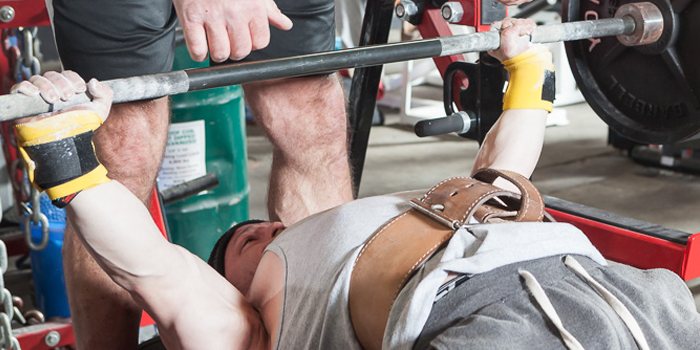
In part one of this article series we discussed how a lifter can go from beginner to advanced in the bench press. We also discussed how your response to training changes with time and as you become more proficient in an exercise.
In this article, we are going to go over how to approach training the bench press as an advanced to elite lifter. I would classify someone as advanced or elite if they are approaching 1.8-2 times bodyweight in the bench press. For heavier lifters, 475-500 pounds is when I would start to consider you an “elite” lifter in the bench press.
RECENT: How to Bench 5 Plates Raw: 0 to 400 Real Quick
Obviously some people will be able to reach these standards easier than others and some might never be able to reach these standards at all. These things, however, are arbitrary by nature, so there is no real merit in getting hung up on the definition. It’s just a benchmark.
What changes when you become advanced or elite?
When you become highly conditioned to any lift, it becomes very difficult to get more toothpaste out of the tube. The easy bits of paste have long since been squirted out, whether that has happened through random pushing and prodding of the tube or through systematic rolling up of the tube using a methodical and results-driven approach. This leaves us in two different scenarios.
Scenario 1: Plenty of Paste Left in the Tube
If you are someone who has gotten strong by applying random training methods or progressive overload week in, week out in some pretty mundane manner, you probably have a great mindset. You also probably haven’t had a coach and probably don't understand training science very well.
This is the best case scenario because you have applied intensity and overload, also known as the “more is more” approach to training. As a result, you have made some very easy and quick gains in the lift. Usually what has happened in this scenario is that you have only explored one or maybe two training variables to get stronger. The most common variables utilized by this kind of training are bolded below.
- Specificity
- Variety
- Volume
- Intensity
- Frequency
- Duration
The typical “linear” periodization model cyclically utilizes almost exclusively these two elements in the program to produce a predictable outcome in training response. There is nothing wrong with this — it obviously works or you wouldn’t be benching over 440 pounds!
As we discussed in the previous part of this article series, training has a dose/response curve the same as pretty much any drug. Due to getting to this level of strength using the crap out of one or two aspects of the core training principles, you can start to explore new and novel programming ideas. Below are some areas you can look into for getting better at a lift you are already pretty good at.
Increase your frequency.
If you have been training bench or “chest” once per week and managed to get to this level of strength then you’re in luck, because you are highly likely to be a high responder. Simply by taking the same volume and average intensities you normally cycle through once per week and doing it two to three times per week, you will almost certainly realize a strength gain. There is a multitude of reasons why this is the case but I’m not going to get dragged down into the physiology or science of these training principals, or this two-part series will end up being a book series.
Increase your training variety.
Have you ever cycled through three to six different bench press variations in a program before? No? Great, because you have another easy avenue you can explore to get some bench press gains. Simply adding in close grip bench press, pause bench press, and rack press into your training regimen with the same volumes and intensities will give you some immediate traction.
Increase your training specificity.
Have you ever tried doing nothing else for bench press other than bench press? Mental idea, I know, but this is genuinely a good idea for some people who follow a template like Westside or who follow a program that calls for a metric shit ton of pressing variation. Everything we do that represents a training stress (anything that constitutes exercise) demands recovery and adaptation. Your body has only so much adaptation to go around, so why not only train the lift you want to get better at for a while?
If you start to program or adapt your training so that you take advantage of these training variables in a cyclical and progressive manner, you can definitely start to get some more gains out of your bench press.
Scenario 2: Hardly Any Paste Left
For a lifter who has been following the work of a coach or has been training using a good variety of programs that are written to take advantage of training variables in an intelligent and cyclical manner, we need to think a bit more outside of the box.
There are some adaptations to these training variables that I put together into the training for my better-trained lifters or athletes. When I say "better-trained" I mean that these lifters have made the most out of what they have genetically; it doesn’t necessarily mean that they are stronger.
Habituation — This is a period of training or adjustment that allows a lifter to get used to a new training framework or stimulus. This period of time only allows a lifter to prime themselves or to preempt the next stage in training.
Stress Load — This is a period of training that deliberately puts the lifter through a period of overload or overreach. Depending on how well-trained the lifter is, this can be sustained only for so long. For instance, novice lifters can train like this for months on end while elite lifters can burn out in as little as two weeks.
Consolidation — A period of training that allows the lifter to either reduce stress from a stress load block and allow their body time to adapt/readjust to the previous stress load, or it allows for a period of deliberately stagnant training to prepare a lifter for a new training block without priming them.
Detraining — A period of time for a lifter to actually go backward. Wait, what? Too many lifters think they should be on the gain train all year long, but the best way to run the gain train off the tracks and into the glass house is to keep moving all year round. Tendons, the nervous system, the endocrine system, the musculoskeletal system — they are a wonderful organic mish-mash. However, they respond to stress on their own time frames and in their own ways. As such, some can get snapped in two if we aren’t careful about how we organize the stress we apply to our bodies.
We will now put this into a program so you can see how it would be applied in the real world.
Scenario: You’ve just peaked for your most important meet of the year and had a shit bench press experience. You are motivated to get back at it and rewrite all your wrongs from the previous training cycle.
Weeks 1-3: Detraining Phase
This phase has no training. Instead, it includes only active recovery, general exercise, and maybe some dumbbells and machines. This period of detraining will do two things: First of all it will allow your tendons and joints some respite, allowing them to recover from your peaking cycle (which will have been low stress for your muscles and endocrine system but high stress on connective tissue).
It will also allow a cooling off period. Often ideas that seem great when you are emotionally-charged or feeling great are terrible ideas. Two to three weeks away from your moment of high passion and emotion will allow you to apply a rational and more measured mind to the task, which almost always ends up in a better outcome.
Weeks 4-6: Habituation
During your time away, you decided that the best course of action for your bench press is to try a program that leans on an increase in volume to provide overload (accumulation) but also has enough frequency for you to be able to specifically practice your competition bench press. The program that best fits the bill is the Russian Squat Routine. So, for your habituation period, you need to get used to training three times per week and build up your volume over the next few weeks so you are hitting the ground running and not overloading from the first workout.
After this three-week program, you should be used to training with 18 total working sets in the week that are spread over three days. You will be used to training the lift three days per week and come from a volume and intensity level where the first week of the stress load or accumulation program shouldn’t be too much of an increase. This should help to guard against injury or overtraining.
Weeks 7-13: Stress Load
Now that you have gone through an introductory training phase, you are now prepared to enter into an overloading or overreaching phase. There are almost an unlimited number of ways we can achieve this goal, but for the sake of practicality, we will be looking at an already-popular overloading/overreaching cycle, the Russian Squat Routine.
The Russian Squat Routine can be applied to any lift. It is especially good for strength lifts that act in an eccentric, concentric manner (i.e. squat and bench press). It works very simply: there is a three-week accumulation phase, called so because you will be accumulating volume and fatigue, which is what will lead to the eventual increase in fitness and strength after the taper.
The accumulation phase looks like this:
There isn’t anything special about the way the program works; it ramps up to 6x6 with 80% using a simple, logical progression from 18 reps to 36 reps at 80% in a workout. It originates from Russian weightlifting where, based on the data in their detailed training logs, they determined that the best way to develop the “slow” lifts (squats, pulls) was an increase in volume at a moderate weight.
Bench press falls into this category. Similar—but maybe less well-developed versions of this sort of programming—can be found in the Smolov Base Cycle or Smolov Junior.
After the accumulation phase, you will begin the peaking phase. Again, this is easy to grasp. It is a linear block — in essence, three weeks of increasing load/intensity in the workouts with a matched decrease in total working volume over the week. This leads to a peak (reduced fatigue, reduced volume, increased performance) but also leads to a net decrease in fitness (strength). For the purposes of this training cycle, we will take the peaking cycle up to the point that will be the 2x2 workout later on in the block.
Peaking phase of the program:
As you can see, the column titled Volume Load (AU) is an inferred measure of the tonnage of the session based on the percentage and the volume (total number of reps performed). With each session, this drops down and eventually the “working” sessions (i.e. the sessions that aren’t six sets of two) end up becoming less in volume load than the standard session (or recovery session, as it becomes later in the program).
A point to note: I have deviated from the initial program to account for the advanced nature of the lifter. There are two reasons for this. First, the outcomes are unlikely to be as favorable as they would be for an intermediate lifter who does the same cycle. Second, I have chosen to air on the safe side, due to the large amount of fatigue from the front end of the stress block and the lack of desire for a true “peak."
You will also notice through the back end of the program—and as you come through the peaking phase—these 6x2 sessions will become easier and easier. This is due to the decrease in global fatigue from the drop in volume load (volume x intensity). As we discussed earlier in the article, this is due to a decrease in fatigue and, on a long enough time frame (two to four weeks), a decrease in overall fitness. In the terms of powerlifting, this "overall fitness" is maximal strength.
Once we have applied the full stress load cycle you will have gone from a period of overreach/volume accumulation into a phase of realizing your work and stressing the neural system and joints. However, you will stop short of taking it to a full peak and will instead transition to the next aspect of the program.
You can find a copy of the program and calculate using your own max by following this link. Just click File and Make a copy.
Consolidation
The goal of the “consolidation” aspect of the program is to hold onto the strength you have gained in the overload part of the program, but in a way that allows you to recuperate and not go backward. The important part of this program is to provide enough intensity and volume to allow you to hold onto your strength gains without continuing to overload, while also providing enough of a dip to allow your body to recover.
Frequency — During this block you will drop a training session, which will add to the recovery element of the program both mentally and physically.
Variation — You will use a greater variety of lifts in this phase of training, more for the mental aspect of the program than for the physical break.
Volume — Volume will go back up to a moderate/high level to allow you to recover from the more neural aspect of the intensification part of the stress block.
Intensity — We will reduce this aspect of the training markedly to allow for recovery. This will not lead to any detraining, however, as the volume load and variety should provide more than sufficient stimulus.
The use of accommodating resistance will also help to provide both variety and a way of adding load or intensity to the lift without using outright weight, which will be much more stressful.
Please note that the calculator uses bench press to estimate shoulder press and incline strength, so you may need to adjust these working loads based on your own training background, as almost all lifters are weaker or stronger on these lifts due to their diverse training backgrounds.
Consolidation phase of the program:
Pulling It All Together
The program given can be done using the calculator provided but it is used more as an illustration of a way of thinking. It shows that in programming for a more advanced lifter, you can change the emphasis yet still pull it together into one whole, planned-out thought of training. More advanced lifters should think of training as truncated portions of time through the year, where they can look at periods of training with distinct goals.
I hope this series of articles has helped you rethink your approach to training and has given you some tools you can use to help progress in the future.
Marc Keys is a professional strength and conditioning coach for Edinburgh Rugby. Prior to working in professional sport, Marc worked for the Scotland Institute of Sport where he was involved in the physical preparation of around 60 Olympic and commonwealth athletes from over 20 different of sport, many of whom went to medal for Team Scotland or Great Britain. As a powerlifter, Marc has been lifting in the IPF for eight years. He has competition best raw lifts of 620-pound squat, 455-pound bench press, and 660-pound deadlift at a bodyweight of 248 pounds. Marc is involved with the training of nearly 100 strength athletes through his online coaching service (onlinestrengthcoach.com) and his barbell club (Edinburgh barbell). If you would like to contact Marc please email speedpowerperformance@gmail.com.









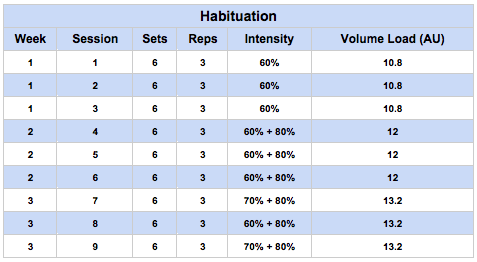
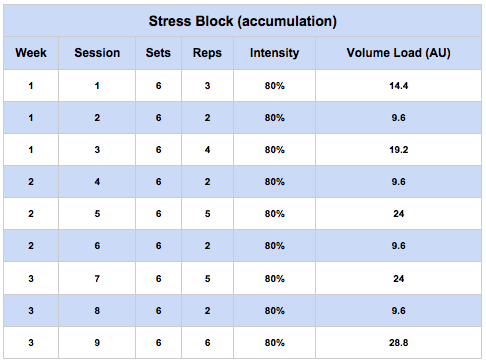
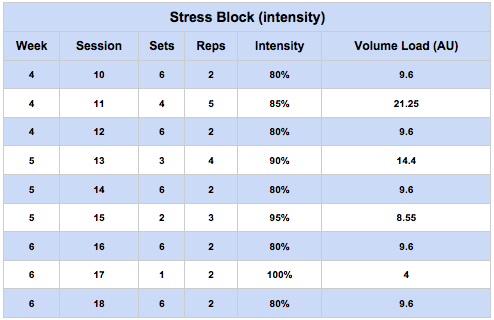
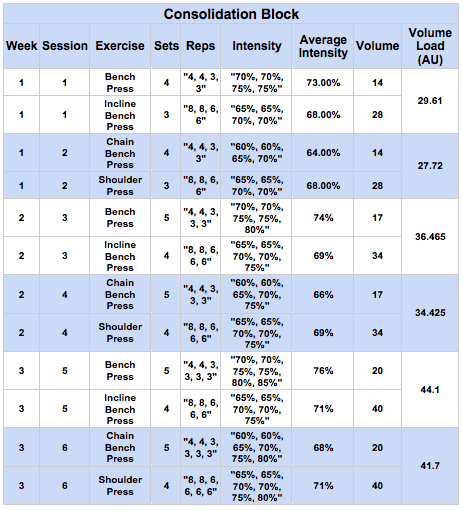
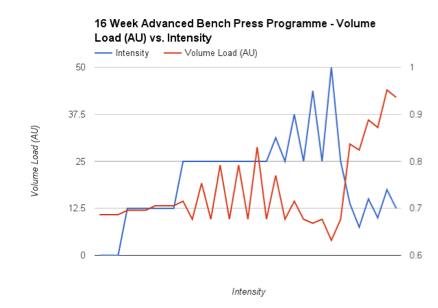

What meet was that in?
Scottish unequipped in June.
Competed today at the 4 nations. Benched 462 and missed 467.5 on a technicality head came off the bench.
All done under Scottish and British powerliftig the IPF affiliate in the UK.
I've been competing in bench in the USAPL (IPF affiliate) for the past 1.5 years working on getting a better comp. max.
At your current level are you training bench 3x/week for certain periods? Or is this something that you use with your athletes.
I'm a Masters lifter and honestly don't think I could bench 3x/week for 6 weeks straight without running into some issues, recovery between sessions being a primary concern.
I bench 3-4x per week, training frequency for bench press never drops below 3x. A typical week for me atm would be
Monday
Bench
60% x 3 x 4
70% x 3 x 2
80% x 3 x 1
1-2 back exercises 2-3 sets of 8-10 reps
Wednesday
CG Bench
60% x 4 x 3
70% x 4
Friday
Pause Bench
60% x 3 x 3
70% x 3 x 2
80% x 3 x 1
85% x 3 x 1
1-2 back exercises 2-3 sets of 8-10 reps
Normally do a bench variation every workout for 4-8 sets, try to keep the average intensity low overall.
I can see this being done at manageable percentages for low reps, this is keeping the daily volume pretty low. But when you ramp up the weights, there is only one heavy bench day per week, correct?
Or are the percentages on the lighter bench day increasing as well?
Actual max or latest heaviest single/double from max 8-12 weeks ago.
I normally have 1-2 heavy sessions (but they are normally 70-75% average intensity so not too bad) I very rarely train anywhere near failure.
Lighter days stay lighter relative to other days.
Sets box says 3 and reps shows 8,8,6,6 for eg.